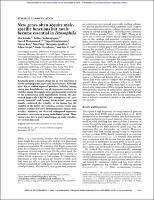Please use this identifier to cite or link to this item:
https://hdl.handle.net/20.500.12202/4141Full metadata record
| DC Field | Value | Language |
|---|---|---|
| dc.contributor.author | Steinhauer, Josefa | - |
| dc.contributor.author | Kondo, Shu | - |
| dc.contributor.author | Vedanayagam, Jeffrey | - |
| dc.contributor.author | Mohammed, Jaaved | - |
| dc.contributor.author | Eizadshenass, Sogol | - |
| dc.contributor.author | Kan, Lijuan | - |
| dc.contributor.author | Pang, Nan | - |
| dc.contributor.author | Aradhya, Rajaguru | - |
| dc.contributor.author | Siepel, Adam | - |
| dc.contributor.author | Lai, Eric C. | - |
| dc.date.accessioned | 2018-11-08T15:31:21Z | - |
| dc.date.available | 2018-11-08T15:31:21Z | - |
| dc.date.issued | 2017-09-15 | - |
| dc.identifier.citation | Steinhauer, J., Kondo, S., Mohammed, J., Eizadshenass, S., Kan, L., Pang, N. Aradhya, R., Siepel, A., Lai, E.C. (2017) New genes often acquire male-specific functions but rarely become essential in Drosophila. Genes and Development 31(18): 1841-1846. | en_US |
| dc.identifier.issn | 0890-9369 | - |
| dc.identifier.uri | http://www.genesdev.org/cgi/doi/10.1101/gad.303131.117. | en_US |
| dc.identifier.uri | https://hdl.handle.net/20.500.12202/4141 | - |
| dc.description | Received June 11, 2017. Accepted September 12, 2017. © 2017 Kondo et al.; Published by Cold Spring Harbor Laboratory Press This article is distributed exclusively by Cold Spring Harbor Laboratory Press for the first six months after the full-issue publication date (see http://genesdev.cshlp.org/site/misc/terms.xhtml). After six months, it is available under a Creative Commons License (Attribution-NonCommercial 4.0 International), as described at http://creativecommons.org/licenses/by-nc/4.0/. | en_US |
| dc.description.abstract | Relatively little is known about the in vivo functions of newly emerging genes, especially in metazoans. Although prior RNAi studies reported prevalent lethality among young gene knockdowns, our phylogenomic analyses reveal that young Drosophila genes are frequently restricted to the nonessential male reproductive system. We performed large-scale CRISPR/Cas9 mutagenesis of “conserved, essential” and “young, RNAi-lethal” genes and broadly confirmed the lethality of the former but the viability of the latter. Nevertheless, certain young gene mutants exhibit defective spermatogenesis and/or male sterility. Moreover, we detected widespread signatures of positive selection on young male-biased genes. Thus, young genes have a preferential impact on male reproductive system function. | en_US |
| dc.description.sponsorship | Acknowledgments We are very grateful to Doris Kretzschmar for sharing unpublished characterization of BACE mutants. We thank Sayani Sen for assistance with fly husbandry, and Mariana Wolfner, the Bloomington Stock Center, and the Developmental Studies Hybridoma Bank for fly stocks and antibodies. S.K. was supported by the Mochida Memorial Foundation for Medical and Pharmaceutical Research. A.S. was supported by National Institutes of Health (NIH) R01-GM102192. Work in J.S.’s laboratory was supported by NIH R15-HD080511. Work in E.C.L.’s group was supported by the NIH (R01-NS083833 and R01-GM083300) and Memorial Sloan-Kettering Core Grant P30-CA008748. | en_US |
| dc.language.iso | en_US | en_US |
| dc.publisher | Cold Spring Harbor Laboratory Press | en_US |
| dc.rights | Attribution-NonCommercial-NoDerivs 3.0 United States | * |
| dc.rights.uri | http://creativecommons.org/licenses/by-nc-nd/3.0/us/ | * |
| dc.subject | Drosophila | en_US |
| dc.subject | gene evolution | en_US |
| dc.subject | spermatogenesis | en_US |
| dc.subject | testis | en_US |
| dc.title | New genes often acquire male-specific functions but rarely become essential in Drosophila. | en_US |
| dc.type | Article | en_US |
| dc.contributor.orcid | 0000-0002-0960-5271 | |
| local.yu.facultypage | https://www.yu.edu/faculty/pages/steinhauer-josefa | |
| Appears in Collections: | Yeshiva College: Faculty Publications | |
Files in This Item:
| File | Description | Size | Format | |
|---|---|---|---|---|
| Genes Dev.-2017-Kondo-Steinhauer1841-6 PubVersion OK.pdf | Publisher's version with permission | 193.78 kB | Adobe PDF |  View/Open |
This item is licensed under a Creative Commons License

